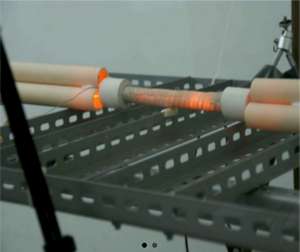The Inconel Mouse of Andrea Rossi's E-Cat
A few reasons given to show why the mysterious mouse component of the high temperature E-Cat may very well be the inconel resistance wires themselves.
 An image of a "mouse and cat" high temperature module. The dark bands visible represent the helically wound inconel resistance wires, glowing more dimly at a lower temperature than the areas of the reactor where fuel powder is present. |
By Hank
Mills
Pure Energy Systems News
For quite a long time, Andrea Rossi, the inventor of the
E-Cat or Energy Catalyzer, has described a particular type of module
that he calls the “Mouse and Cat” configuration. This was the type of
reactor used in the report published on Oct. 8th (see our
news compilation page about this momentous event) of a month long
test of a high temperature E-Cat. There has been some confusion as to
what part of the reactor was the mouse and which part was the cat. Now,
it seems to me that enough information has emerged that we can conclude
that the mouse portion of the reactor was actually the doped, high
temperature grade inconel resistor wires.
Andrea Rossi has provided descriptions of the mouse and cat
configuration several times on his blog and website, the
Journal of Nuclear
Physics. In brief, the setup is described as a reactor having a
smaller mouse that activates to stimulate the larger cat. When the cat
is stimulated, the mouse is turned off until the cat is no longer
adequately stimulated. Then the mouse is turned on again. He has stated
that by using this method of periodic stimulation by the mouse a
start/stop or self-sustain mode can be utilized that allows for higher
COPs. The mouse is stated to have one type of charge and a very low COP
(but greater than 1) and the cat is claimed to have another type of
charge and a high COP.
Here are some of the reasons why I think the inconel resistance wires
are a perfect fit for the “mouse” of this setup.
- Andrea Rossi has recently stated that the reactor tested in the recent report contained both the mouse and the cat portions.
- He has also stated that there was only one type of powder present in the reactor.
- He has stated that when start/stop or self sustain mode is not used, the difference between the mouse and the cat vanishes.
- He has stated that his resistors in the E-Cat are doped and have non-linear characteristics.
- Inconel wires are composed of a high percentage of nickel in addition to other elements.
- The tiny reactor does not appear to have any other internal parts other than the helically wound resistance coils.
- The resistance wires would indeed serve the same purpose as a mouse in start-stop mode – which was not used in the report. They would come on to stimulate the cat and then turn off when the reactions were at an adequate level.
- We know some cold fusion experiments actually utilize specially processed wire of various alloys including nickel. In this case, the resistance wires in the reactor were already doped – which is common to, for example, increase resistance to corrosion or increase operating temperature – and they would be exposed to the same environment as the rest of the reactor.
What this tells us is that, most likely, the inconel wires are indeed
the mouse. They not only provide heat and magnetic stimulation for the
powder but also produce a small amount of excess heat themselves. If
proper replications are to take place, it would be great if we could
discover exactly what alloy of inconel wires are being used. However, I
think it is likely Andrea Rossi has probably doped or modified them in
certain ways (perhaps manipulating their surface features to allow for
reaction sites to exist) that allow them to produce excess heat. In
addition, they have probably been treated in a certain manner to allow
them to withstand the high temperatures and otherwise damaging
environment of the E-Cat.
The idea of the mouse and cat system is brilliant. If you are going to
use resistance wires to heat and stimulate a reactor, why not have them
produce excess heat at the same time? This idea allows you to actually
produce a gain via two methods: the wire that provides stimulation and
from your powder.
I may be incorrect about this assumption, but it all does seem to fit.
Hopefully, we can learn more in the future about the resistance wires
used.
As always, we urge that if anyone does replicate this technology, and
then seek to go commercial with it, that they do so with the blessing
and agreement of Rossi and Industrial Heat, LLC. Do the right thing.
www.pureenergysystems.com
PES Network, Inc.
Copyright © 2003 - 2014
http://pesn.com/2014/10/14/9602548_The_Inconel-Mouse_of_Andrea-Rossis-E-Cat/